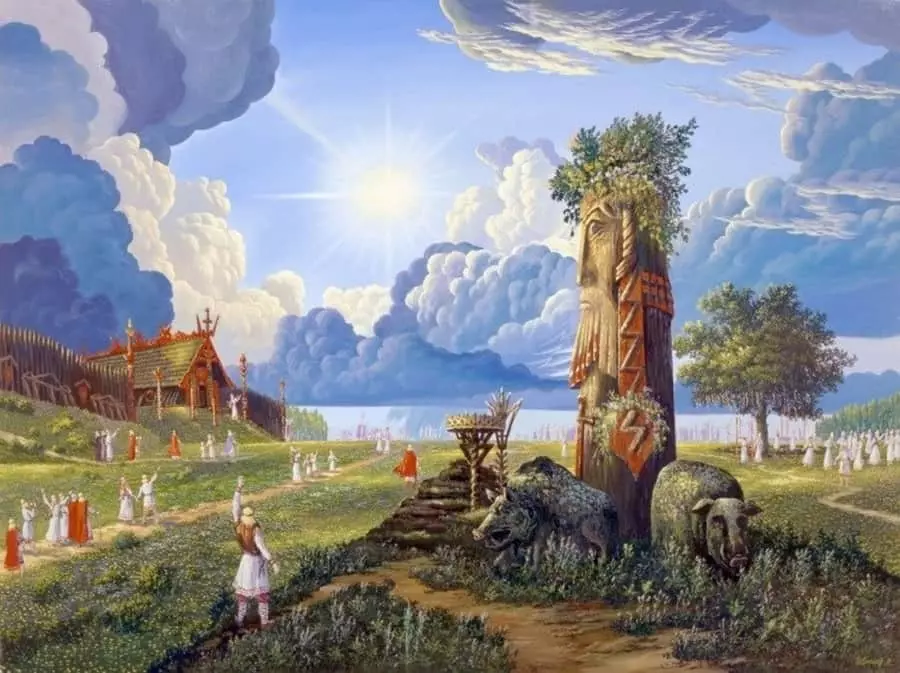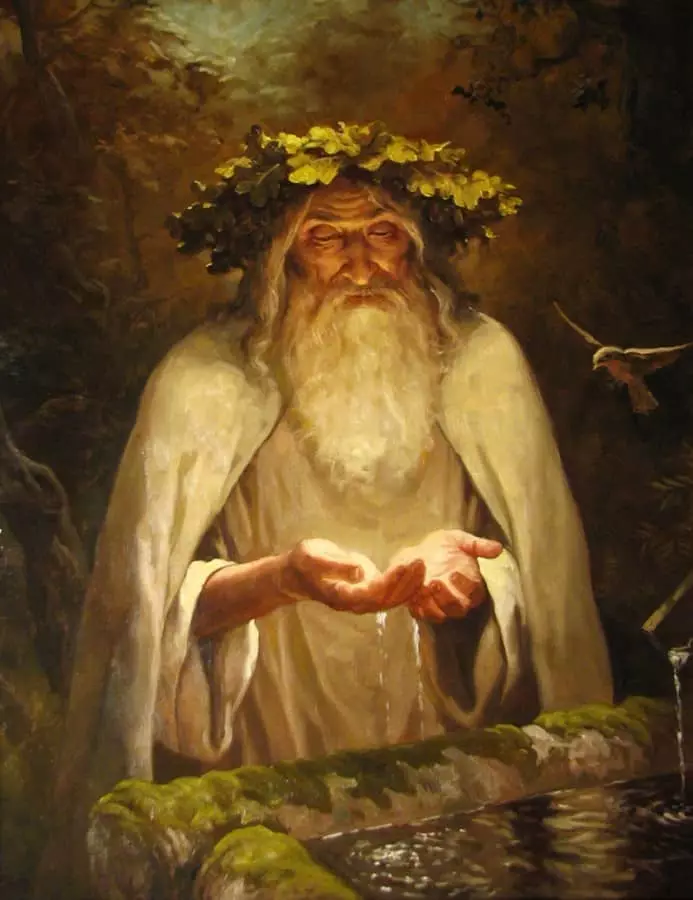Persianism in Russia is a combination of pre-Christian ideas about the world and humanity, which adhered to the ancient Slavs. He was the official and main religion in the Old Russian state until 988, when the baptism of Russia was baptized.
But even after, up to 50 years of the 13th century, people secretly continued to adhere to paganism, neglecting the prohibitions of the ruling elite. And even when the Slavic paganism completely replaced the Christian faith, some of the customs and beliefs continued to strongly influence the features of Slavic culture, traditions and life in general. Nowadays, there is a partial revival of pagan knowledge.

Characteristics of the pagan ancient Russia
Find out what awaits you today - a horoscope for today for all zodiac signsBy numerous subscribers requests, we have prepared an accurate horoscope application for a mobile phone. Forecasts will come for your zodiac sign every morning - it is impossible to miss!
Download free: Horoscope for every day 2020 (Available on Android)
We have reached very little information about the religions of the ancestors: the initial passages of information about Slavs tell written sources of the 6th century, when they are closely in contact with the Byzantine Empire. Most of all is known about the Old Slavic Divine of Perun, who in the pagan Pantheon got the role of the Ruzhozhtsy, the God of Lightning and War.
It is also possible to attribute the following types of concepts to Praslavyansky:
- Spirit, soul;
- Nava (the world of the dead, dead);
- Paradise (otherworldly measurement);
- Volkolak (Werewolf);
- Ghoul (bloodstream);
- Treba (sacrifice).
In paganism, the concept of the soul is radically different from modern, Christian. So, the soul was perceived not as a material entity, but were represented in the form of a person himself, after the physical death of the Navi leaving.
Specific traits
Several basic characteristics of paganism as a system of worldview, namely:
- Our ancestors are spiritualized by the Forces of Nature, worshiping them;
- honored the memory of his great-grandchildren;
- believed in the otherworldly forces, which take place in the life of a person and directly affect it;
- were convinced that with the help of magic, the impact of certain types of energy can be changed its life in the right direction;
- Healed diseases using prayers and methods of natural medicine.
Since there are no authentic mythological texts, then all the information about paganism of Slavs is provided exclusively to secondary sources: archaeological and book-written data (chronicle, chronicle and the like), as well as foreign evidence, Christian teachings against paganism. In addition, they compare Slavic data with the data of the rest of Indo-European crops (Baltic, Iranian, German and others).
At the same time, the most reliable is called called "modern" (attributable to 19 and 20 centuries) of the evidence of the pagan rites of a language, ethnographic and folk nature.
Attitude towards deities
After examining archaeological information, and also familiarized with written sources, we see that the ancient Slavs created the sculptures of their gods (called idols). Manufacturing material served wood and stone. At the same time, it is characteristic that the idols of the eastern category of Slavs were simpler, rude, and Western-made harder and more elegant.
Worship in front of idols was carried out on open sanctoes (known as the Kapieff). As a rule, instead of temples, Slavs went to the forest. The exception is only Western pagans. True, there is a version that the temples were wooden and over time they were simply collapsed, without leaving no trace.
On the walls were performed various rituals of worship in front of idols. The sanctuary was usually struck, also bonfires were burned on them, temporary or permanent. Information from the chronicles speaks of multiple PERUNIs, which were in Novgorod, as well as on the perch. There are assumptions that they were discovered in Soviet times, but a thoroughly hid this fact from the population. Of the promulgated archaeological finds, you can talk about the Zbruch cult center.
Now theories are often arising about the fact that the sanctuations of the North-Western Slavs were hills, which are sacral monuments. Sopgia is a mound made on graves. In any case, the embankment had a ritual function more than the funeral. Some of the remains of such a sanctuary may be found on the perch. But the Slavs bowed not only to idols, and even before sacred boulders.

The letter written by Metropolitan Makaria Tsar Ivan Grozny in 1534 is of interest. It reads about the preservation of "bad idolism" until the reign of Prince Vasily Ivanovich. It is still talking about the use for prayers "forests and stones and rivers and swamps, sources and mountains and hills, sun, and months, and stars, and lakes."
Priese
According to some scientists, the leader (holding the post of Prince) in the ancient Slavs owned both administrative, military and religious functions at the same time.
Already in the second half of 1 Millennium, our era, Slavs occupy too much territory, and therefore there is a difference in their public development:
- Residents of southern regions It turns out to be under the strong influence of the Byzantine Empire (in particular, the Christian religion), so they are gradually eliminated from them.
- Living in western regions Slavs In its development ahead of the fellow. Ancient sources talk about the great impact in their priesthood, subsequently by the entire political power.
- As for the eastern category, They only had a priesthood, but was interrupted by the establishment of Christian faith. It is believed that Eastern Slavs also had priests in the pre-Christian time.
True, it is likely that more fortune-tales, sorcerers and the signs prevailed. In ancient Russian sources, they carry the name of the Magi, the leaders, magicians, Kudesniki, Growing, and so on.
Such people were engaged in the sign, that is, they were treated with the help of leadership, rites and natural medicines. At the same time, they practiced domestic magic (love and coamental character). Various rituals were performed, special potions were manufactured, talismans, charms and other mystical items. They wondered in various ways: with the help of a bird and animal scream, in the wax, tin.

How Christianity has displaced paganism
In order to replace the paganism of ancient Russia Christianity, the Byzantine Empire was interested. She was needed, as it was believed that any nationality, taken Christianity from the emperor and the Patriarch, turns the default in Vassal of Byzantium. And the maintenance of relations between Russia and Byzantium allowed the Christian religion to gradually be provided in the Russian environment.
The chronicles argue that Prince Vladimir initially chose Christianity as faith for himself, and then decided to baptize all Russia. Allegedly, the prince with his surroundings listened to missionaries from various denominations: Muslim Bulgaram, Roman Germans, Khazar Jews and "Byzantine-Greek philosophers".
It is believed that after that the ruler sends associates in different parts of the country, giving them a task to derive which religion will be the best. And those, returning, answered that the most good - Vera Greek.
Scientists suggest that the approval of the Christian faith was significantly influenced by pragmatic considerations: it was important that the new religion would contribute to the religious and ideological reinforcement of the statehood and the authorities of the rulers of Kievan Rus.
At the same time, the introduction of the prince Vladimir Christian faith in Russia was only the starting point in this process. Subsequently, the pagan worldview gradually went out, was forgotten, it was not stretching for years, but many decades.
During the rule of Vladimir, Christianity accepted only his family, a squad. The larger part of people continued to stick to the panels until the 11th century. Although even in the first half of the 12th century, according to information from ancient chronicle, people still engaged in pagan religious acts.
Until the middle of the 13th century, on archaeological finds, Slavs continued to perform pagan rituals. And in the applied art of those times, more or less pronounced pagan symbols are traced. And we are talking about the big cities, and as for the villages and the villages, then in them the process of introducing Christianity was even slower.
Only representatives of the third generation could be considered full-fledged Christians after Russia was signed, which they lived in Yaroslav Mudrome.
And although the authorities created a lot of prohibitions, the paganism to the invisible thread of Naughty in Orthodoxy, forever rooted in Russian traditions and customs. And today, many people adhere to traditional Slavic holidays: Maslenitsa, Ivan Kupala, a shin, clean Thursday, Great and others.
And even more - now, over the past decades, the gradual flourishing of Slavic culture began to be observed. There are many communities that restore native traditions and bring everyone to them all. They reveal to people knowledge, very long been in the oblivion, which help in creating their happy, healthy and successful life.
If you wish to get a little more information on this topic, then I advise you to get acquainted with the following video:
